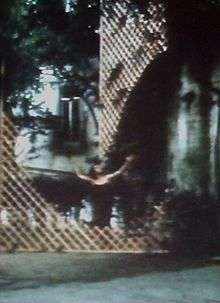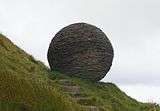Site-specific art

Site-specific art is artwork created to exist in a certain place. Typically, the artist takes the location into account while planning and creating the artwork. Site-specific art is produced both by commercial artists, and independently, and can include some instances of work such as sculpture, stencil graffiti, rock balancing, and other art forms. Installations can be in urban areas, remote natural settings, or underwater.[1][2][3][4][5][6]
History
The term "Site-specific art" was promoted and refined by Californian artist Robert Irwin, but it was actually first used in the mid-1970s by young sculptors, such as Patricia Johanson, Dennis Oppenheim, and Athena Tacha, who had started executing public commissions for large urban sites. Site specific environmental art was first described as a movement by architectural critic Catherine Howett and art critic Lucy Lippard.. Its emergence was also influenced by the modernist objects as a reaction of artists to the situation in the world.
Modernist art objects were transportable, nomadic, could only exist in the museum space and were the objects of the market and commodification. Since 1960 the artists were trying to find a way out of this situation, and thus drew attention to the site and the context around this site . The work of art was created in the site and could only exist and in such circumstances - it can not be moved or changed. Site is a current location, which comprises a unique combination of physical elements: depth, length, weight, height, shape, walls, temperature.[7] Works of art began to emerge from the walls of the museum and galleries (Daniel Buren, Within and Beyond the Frame, John Weber Gallery, New York, 1973), were created specifically for the museum and galleries (Michael Asher, untitled installation at Claire Copley Gallery, Los Angeles, 1974, Hans Haacke, Condensation Cube, 1963–65, Mierle Laderman Ukeles, Hartford Wash: Washing Tracks, Maintenance Outside, Wadsworth Atheneum, Hartford, 1973), thus criticizing the museum as an institution that sets the rules for artists and viewers.[7]
Jean-Max Albert, created Sculptures de visées in Parc de la Villette related to the site, or Carlotta’s Smile, a trellis construction related to Ar. Co,’s architecture Lisbon, and to a choreography in collaboration with Michala Marcus and Carlos Zingaro, 1979.[8]

Examples
Outdoor site-specific artworks often include landscaping combined with permanently sited sculptural elements; it is sometimes linked with environmental art. Outdoor site-specific artworks can also include dance performances created especially for the site. More broadly, the term is sometimes used for any work that is more or less permanently attached to a particular location. In this sense, a building with interesting architecture could also be considered a piece of site-specific art.
In Geneva, Switzerland, two Contemporary Art Funds of the City have been looking forward to integrate art into the architecture and in the public space since 1980. The Neons Parrallax was conceived specifically for the Plaine de Plainpalais whose perimeter, located in the heart of the city, the challenge of the artists invited was to transpose commercial advertising signs of the harbour into artistic messages.[9]
Site-specific performance art, site-specific visual art and interventions are commissioned for the annual Infecting the City Festival in Cape Town, South Africa. The site-specific nature of the work allows artists to interrogate the contemporary and historic reality of the Central Business District and create work that allows the city's users to engage and interact with public spaces in new and memorable ways.
Gallery
 Robert Smithson, Spiral Jetty from atop Rozel Point, 2005.
Robert Smithson, Spiral Jetty from atop Rozel Point, 2005. Side effect X, Eberhard Bosslet; Tias, Lanzarote, 2008.
Side effect X, Eberhard Bosslet; Tias, Lanzarote, 2008. View of an installation from Strandbad Seedorf, Switzerland, 2015.
View of an installation from Strandbad Seedorf, Switzerland, 2015. A rock balance, England, 2013.
A rock balance, England, 2013. The Globe, Knockan Crag National Nature Reserve, Scotland, 2007.
The Globe, Knockan Crag National Nature Reserve, Scotland, 2007. Olafur Eliasson's Waterfalls under the Brooklyn Bridge, 2008.
Olafur Eliasson's Waterfalls under the Brooklyn Bridge, 2008. Site specific dance by Blue Lapis Light at the Texas State History Museum in Austin, Texas, 2010.
Site specific dance by Blue Lapis Light at the Texas State History Museum in Austin, Texas, 2010.- Site-specific sculpture by TEJN, Copenhagen, 2014.
See also
References
- ↑ http://www.lataco.com Interview with Rafael Schacter, Author of The World Atlas of Street Art and Graffiti.
- ↑ http://www.nytimes.com Aerosol Art.
- ↑ http://www.filippominelli.com Filippo Minelli "Silence/Shapes."
- ↑ Rafael Schacter, author of "The World Atlas of Street Art and Graffiti", September, 2013; ISBN 9780300199420.
- ↑ http://www.brooklynstreetart.com Rafael Schacter and His "World Atlas of Street Art and Graffiti."
- ↑ https://www.youtube Gravity Glue 2015; (Underwater Rock balance at 3:55).
- 1 2 Miwon Kwon. "One Place After Another: Site-Specific Art and Locational Identity". – London and Cambridge, Mass.: Massachusetts Institute of Technology, 2002.
- ↑ http://www.arcoabecedario.pt/entries/41?locale=en
- ↑ Neons Parrallax
External links
 Media related to Site-specific art at Wikimedia Commons
Media related to Site-specific art at Wikimedia Commons